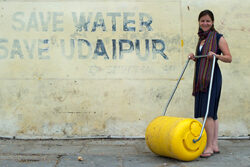http://www.youtube.com/watch?v=ST0dSEFiVosCynthia Koenig knows that by reinventing the wheel she could change the world. In a few months, she hopes to make a difference in India.Koenig, a graduate student at the University of Michigan, created the WaterWheel, a 20-gallon rolling water barrel, and Wello, the business that distributes it in developing countries, where clean water is scarce.

Cynthia Koenig’s WaterWheel, and the innovative micro-finance plan that helps people afford it, is a strikingly low-tech solution to the problem of gathering drinking water in the developing world.
After graduation this spring from U-M’s Stephen M. Ross School of Business, Koenig plans to launch a pilot program in Rajasthan, India to test the WaterWheel’s social impact and health benefits. Her goal is to sell 5,000 wheels in 12 months, positively impacting the lives of 40,000 people. She is working with an Indian company to manufacture the wheel.The 20-gallon rolling barrel provides enough water for drinking, personal hygiene and household cleanliness to meet the daily needs of four people in a single trip, according to United Nations guidelines.Koenig’s project is receiving recognition throughout the world. She her teammate Colm Fay, both graduate students in the Erb Institute for Global Sustainable Enterprise, a joint program with the Ross School and the School of Natural Resources and Environment, won $10,000 in the Global Social Entrepreneurship Competition at the Foster School of Business at the University of Washington in Seattle.”This is a great honor and the competition has been a great experience,” Koenig said.

For many in the developing world, especially women, gathering water is a grueling daily chore.
Students competed for prizes in the international social venture plan competition, where interdisciplinary student teams from around the world proposed creative, commercially viable businesses designed to reduce poverty in the developing world. The semi-finalists were selected from 100 teams in 24 countries.In 2010, Koenig’s team was one of three with winning ideas in the Dow Sustainability Innovation Student Challenge. Wello’s goal is to effectively deliver clean water to a thirsty world. By reframing the water crisis as an opportunity, Wello has developed an innovative business model that empowers individuals to use the WaterWheel as an income-generating tool to lift their families out of poverty, according to Koenig. Women and girls, for example, could be freed to pursue and education and avoid the injuries related to carrying the water jugs.

Koenig has field-tested the WaterWheel, brought its cost down, and come up with a microfinance plan to help people afford it.
One in six people in developing countries access to water means hours of walking and heavy lifting. Five gallons of water weighs 44 pounds and women and girls, often the household water carriers, stand in long lines and carry heavy water jugs on their heads up to eight miles a day.”In recognition of the fact that the people who need products like the WaterWheel the most have the least ability to afford them, we’ve developed a business-in-a-barrel model,” she said. “It enables our customers to finance the purchase of a WaterWheel with a microfinance loan and use the tool to deliver clean water door-to-door, earning income in the process.






Bill Grover - 1963
Very cool.!
I didn’t hear anything about purification of the water between the source and the end use.
I imagine you are thinking about how to purify water found closer than the clean water, maybe putting something like reverse osmosis into the product.
Very cool
Happy Trails, Bill 239 597 7372
Reply
Tom Gamble - 1969
Great idea! However, the large flat base is hard to roll over rough ground. It would be much easier if there were a larger diameter, essentially wheels, near the ends of the tank. Also, pulling is easier than pushing.
Reply
Thomas Wooding - 1967 & 69
Reinventing the wheel! What an inspiring story! And very well told in your article, and shown(and expertly narrated by Ms. Koenig)in your video!
I am really, really impressed. Congratulations & best wishes.
This story I’ll e-mail to all my friends, even if they aren’t UM grads.
Reply
Oliver Page
There has been much comment on this wheel on the Umich website. Challenges that I see it being widely adopted in resource poor countries are: smooth surface required – try pushing a fully laden wheel along a gravel road with potholes or uphill along a mountain path; at times the wheel may require lifting to negotiate an obstacle along the route; the metal handle may not prevent blisters; and how many people are required to push or empty a fully laden wheel, if children would this be ethical?
Reply
John Nichols - '51
Impressive. I have been working with Sudanese refugees resettled in Mid-Michigan. Clean water in their villages is much needed. The water-wheel may help. Bio-sand filters are helping in many developing countries and combined with the water-wheel could assure clean water.
Reply
Shahed Samadi - 2005
Simple and so effective! This will certainly have a positive impact on the lives of women and their families who are burdened by such time/labor intensive activities. I have no doubt that the waterwheel will be overwhelmingly successful practice in rural parts of lower income countries. Thank you Cynthia for your concern for others and reaching out to the world. You are an example for others and I wish you the best in your future projects and career ambitions. UMSPH Class of 2005
Reply
Katchen Schibilsky
What a great idea!!!Cynthia Koenig,you are a Genius.This is not only a great idea for the watercarrying women in developing countries,but also for local Hoophousegrowers,who are unable to dig a 200 yard waterline below the frostline.I carry my water all winter(great execise)but at times too slippery.Is it possible to purchase the waterwheel at the local”Downtown Home and Garden”and have a program,like”Buy one,Sponsor One”?Looking forward to more info….Thank you Cynthia Koenig!!!!Katchen
Reply